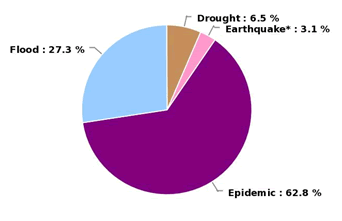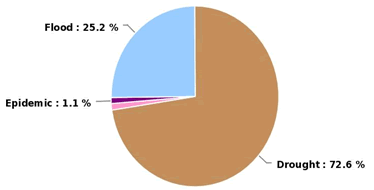Abdiweli Sulaiman Abdi
Tuesday, January 01, 2013
In addition to this, giant industrial factories in the developed world that are in economic competition are producing all those goods we buy and sell in our markets across the country, and these industries outputs are not always friendly to our environment. The closest examples are the millions of cars on our roads that are emitting billions of tones of C02 everyday. Moreover, millions of tones of toxic waste materials are being dumped in our coastal regions, and Somalia is one of the countries targeted by this toxic waste practice, making our innocent population susceptible to the adverse impact of environmental disasters.
Without knowing their contribution to climate change, Communities in Somalia are engaging in charcoal burning for cooking, lighting, heating and export. This practice has been deduced to have contributed to the rapid encroachment of desertification and exacerbation of greenhouse gases in the atmosphere and is destroying Somalia’s environmental heritage. The question everyone should ask here is: are the Somalis aware of what is the climate change, its subsequent adverse impact and other environmental disasters? Are we aware of their crucial role in fighting the climate change and reducing the impact of disasters? The fact is that a handful of Somalis are aware of the changing weather patterns and seasons but the majority of our people are still unaware that climate change caused by the excessive of greenhouse gases.
Greenhouse gases, the root causes of global warming and climate change has created profound effects on the living conditions of people worldwide. For instance, while most parts of Australia and Indonesia were under water in March 2010, some parts of Greece and Israel had wildfires in the same year; whereas in 2011 the worst drought which led to a famine in over half a century has hit Somalia and other east African countries; affecting more than 10 million people.
A countless number of people, densely populated in the low –laying settlements are expected to be at risk from coastal flooding due to sea level rise. Moreover, scientists believe that approximately 20-30 percent of animals and plants species are more likely to vanish if the increase in global average temperature exceeds 1.5-2.50C. In addition, empirical research suggests that approximately 75 to 250 million people in Africa will be exposed to water shortage due to climate change by 2020 and during the same period, yields from rain-fed agriculture in some African countries could be reduced by 50 percent.
Disasters in Somalia
Somalia is experiencing a number of recurring disasters as it is reported in a number of disasters data bases such as Emdat:
Top 10 Natural Disasters Reported
|
Disaster |
Date |
Affected People |
|
Drought |
2008 |
3,300,000 |
|
Drought |
2010 |
1,400,000 |
|
Flood |
1997 |
1,230,000 |
|
Drought |
2000 |
1,200,000 |
|
Drought |
1987 |
500,000 |
|
Flood |
2006 |
299,000 |
|
Flood |
2000 |
220,000 |
|
Drought |
2004 |
200,000 |
|
Flood |
2006 |
155,500 |
|
Flood |
2000 |
150,000 |
Percentage of reported people killed by disaster type

Percentage of reported people affected by disaster type
The data presented above is reasonably clear and shows the fact that there is an enormous challenge ahead as to what should be done to mitigate those recurring disasters and why are we trapped in this cycle? It is also worth to remember that Somalia's long coastline, the longest coastline of Africa is about 3,898 kilometres long and about 55 per cent of its population lives along this coastline. 0n 26 December 2004, Somalia was hit by the tsunami that killed more than 300 people and destroyed homes, boats and fishing equipment and about 18,000 households were estimated to be directly affected.
The recent tropical cyclone that threatened Somalia is amongst the most powerful and destructive meteorological systems on earth that Somalia should be aware of. With the current global warming, Somalia is at risk and has all the six main requirements to suffer from this types of tropical cyclones again and again; and those requirements are: sufficiently warm sea surface temperatures, atmospheric instability, high humidity in the lower to middle levels of the troposphere, enough Coriolis force to sustain a low pressure center, a preexisting low level focus or disturbance, and low vertical wind shear.
The combination of the disasters Somalia is prone to and the disasters occurrence predictions from scientists clearly show that the worst is yet to come. At this era, Somalia can not afford to loose so many lives again. Therefore an effective disaster management, a well warned and informed population and a coordinated joint of responders are needed.
In the world of today, there is no government, organization, business or company that can afford to give disaster a blind eye or a deaf ear whereas it is a major concern in all nations. In order for all activities and businesses to run smoothly and effectively, there is a need to counter disaster from all spheres. It is unfortunate and we cannot afford to see Beletweyn flooded unnoticed, or irrigation water pumps in Bardera washed away, or cyclones hit our long coastal inhabitants in Qandala, Caluula and Bandar Bayle without proper awareness, knowledge of the disaster’s nature and the capacity for those communities to bounce back.
That being said, the best way to deal with disasters is a good practice from community resilience activities undertaken elsewhere. In this case, Small Island Developing Countries would serve a good example and we should learn from them as they have been a victim of all those major disasters whilst sharing a lot with Somalia in terms of vulnerabilities. Furthermore, the role of local authorities and service providers if there are any, cannot be ignored. Without the good will, support and professionalism of both elected and unelected local officials, nothing can be achieved. Communities do not exist in isolation, but are dependent on interactions with and inputs from institutions and organisations inside and outside of their immediate geographical location. Finally, the Somali government and all authorities in the country from district level to the cities and other National and International organisations/stakeholders have to play a role in influencing the course of the disasters prevention and mitigation activities in their respective locations.
The key message here is that, many of our communities who are living in fragile and hazard prone environments should no longer be seen as helpless victims that just wait to be rescued after the impact of floods, droughts or other calamitous events. Something needs to be done to help them to analyse their particular situation, the hazards they face, and their vulnerabilities and capacities. And eventually help them to identify the opportunities to improve their situation.
Abdiweli Sulaiman Abdi is the Chief Executive Director of Disaster and Emergency Management Training and Consulting (DEMTAC) and can be reached at: [email protected] or [email protected]